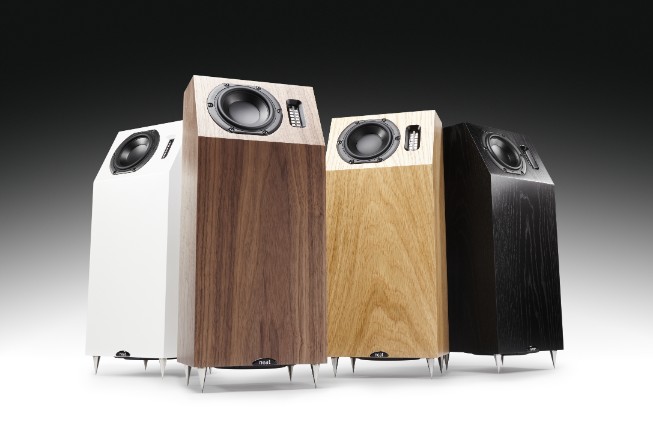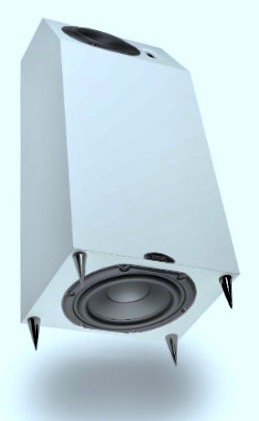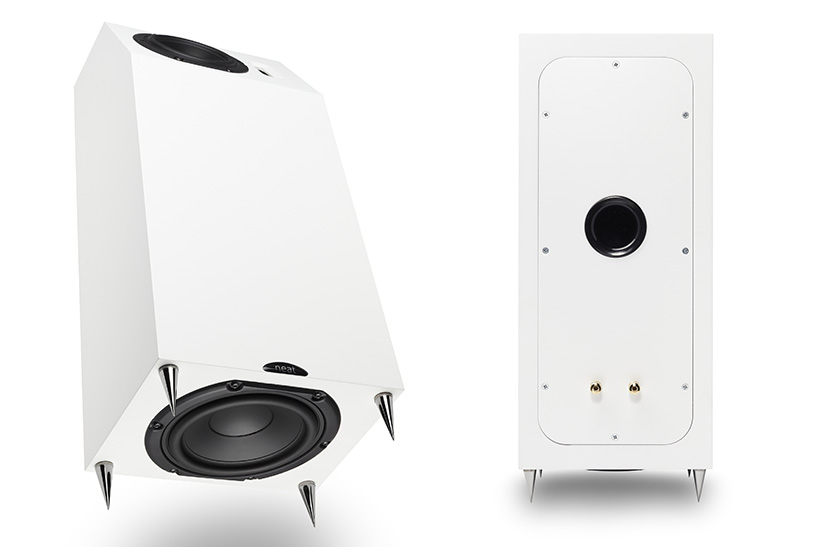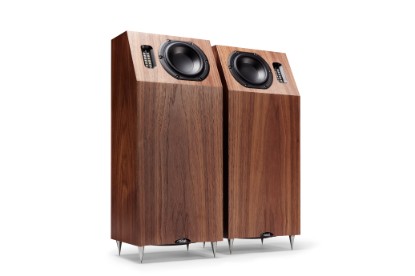
Last year at the Los Angles Audio Show going from room to room as I usually do, I entered one of the two High Fidelity Services’ rooms and saw the smallest pair of floor-standing speakers that I had ever seen; they weren’t quite 18 inches high. I believe in my show report, I said the sound from these Iota Alpha speakers was “jaw-dropping.” I heard them again at RMAF and this year at AXPONA. Every time I’ve heard them, I’ve been amazed. So, I got with Paul Manos, the owner of High Fidelity Services who imports the NEAT Acoustics speakers, and told him we had to quit just talking about these little guys and get me a pair to review. So, between the AXPONA and Munich shows, Paul made sure I got a pair in, and we have been enjoying them.
Description
As I’ve said, the Iota Alpha speakers are small measuring only 17.6″ high by 7.8″ wide by 6.25″ deep. Very sturdy and sharp spikes lift the speaker 1½” off of the surface they are placed on. The speakers have a sloped, time-aligned and sealed upper section that houses a 2″ high EMIT type planar magnetic tweeter and a 4″ midrange drive-unit. The whole of the ported lower section is dedicated to augmenting the lower frequencies via a downward-firing 5.5″ pulp, paper drive unit mounted on the bottom panel.
The crossover is a simple two-and-a-half-way design employing 1st and 2nd order slopes. The crossover is a hardwired, point-to-point device that includes British Volt, Mundorf and Audaphon German inductors, as well as British ICW Clarity capacitors. The woofer is rolled off beginning at 80Hz; the midrange hands off to the tweeter at 5kHz. You have four choices of finishes; satin white, black oak, natural oak, and American walnut.
Our daughter-in-law and three-year-old granddaughter were at our house when the UPS driver brought the box with the speakers to the door. I asked where the second box was, and he said the shipping order was for just one box. Even so, I was surprised that one box contained both speakers. Becky had not heard the speakers at AXPONA, but she had heard me go on and on about these speakers, so she suggested I open the box to take a look. My first impression was that they were smaller than I remembered. My daughter-in-law thought they were so cute, and my granddaughter, who is used to my Teresonic Ingenium XRs, was happy to be taller than the speakers.
Setting Them Up
 You have to use the spikes that are supplied to get the downward firing woofer the correct distance above the floor. If you are using them on a carpeted floor, I highly suggest you place them on a spiked amp stand or on a couple of small cutting boards with spikes on the bottom side that will pierce the carpet. On wooden floors, I would simply use the spikes and the little brass cups that come with them to protect your floor.
You have to use the spikes that are supplied to get the downward firing woofer the correct distance above the floor. If you are using them on a carpeted floor, I highly suggest you place them on a spiked amp stand or on a couple of small cutting boards with spikes on the bottom side that will pierce the carpet. On wooden floors, I would simply use the spikes and the little brass cups that come with them to protect your floor.
Placement is not difficult, but you can’t just plop them down right up against the rear wall or they will be very bass heavy. I found these speakers sounded best in my room about 14 inches from the back wall and about eight feet apart with no, or very little, toe-in.
I used them with my Electrocompaniet PI 2D Prelude Integrated Amplifier that puts out 100 watts into 8 ohms and 165 watts into 4 ohms. The source was OPPO’s UDP-205 4K Ultra HD Blu-ray Player. For speaker cable and interconnects, I used the Audience AU24SX. My power cables were the Audience PowerChords.
I tried them in a couple of spots. First, I placed them on a hardwood floor, and I also raised them about 10 inches off of the floor on either end of my huge, heavy entertainment system. They sounded very similar in both locations, but they were slightly better on the entertainment center. If I was going to use them on the floor, I think they would sound best on a pair of 4″ thick blocks of maple resting on 1.5″ spikes, though this is not necessary for good sound.
Listening To Music
I can’t comment on how long these speakers take to break in since the pair I reviewed had lots of playing time already on them. My first impression was how big they sounded and how the music seemed to float above the speakers. Becky’s first impression was that she loved how the bottom octaves sounded. I let them play all afternoon and evening and, after playing for about 20 hours, I settled down to listen to music.
If you have never heard a speaker that uses EMT planar-magnetic tweeters, you are in for a real surprise, and it may take a few tunes to get used to the sound. A conventional silk-dome tweeter can’t match an EMT’s wide-open, high-frequency sound and upper-range resolution. The difference is significant. Now, don’t misunderstand, the sound is the opposite of etched. The treble information and midrange sound sweet, smooth, airy and spacious. They are magical when it comes to space; the sound literally floats above, behind and to the outside of the speakers. Their placement of instruments and voices is more lifelike than for most speakers in that they are all part of the whole that floats above the speakers.
This wonderful holistic soundstage would be useless if the sound weren’t musical, but it is! This was by far and away the most listenable sound I have heard from my digital/video system. For the first time ever, I found myself listening to this system for hours. These speakers sounded great with my OPPO UDP 205 and the Electrocompainet amp. The sound was full, warm, but never too warm, and it has a beautiful tone. The bass extension for such small speakers was hard for me to believe. I’m not talking about bass caused by an upper bass bump, but deep, tight, tuneful bass frequencies. The bass is dependant on placement. If you get them to close to the rear wall, they can sound bass heavy, and likewise if too far out into the room, they can seem thin. I am not talking about moving them an inch or two; they are not that fussy about placement.

Listening to orchestral music on the Iota Alphas was revelatory. They projected both the flow of the music and the interplay of individual instruments with stunning realism. There was beautiful air around the instruments as the entire orchestra seems to float above the speakers. They never sounded etched or had that phasey sound that is sometimes mistaken for air and space. Instead, they sounded tactile and full-bodied with tones that were rich and full of musical colors. The Iota Alphas sound was coherent from top to bottom with the planar-magnetic tweeter smoothly integrating with the midrange and bass drivers. Orchestras were reproduced as a large, living, breathing and dynamic living thing. If the recording was up to it, they also conveyed the ambiance of the venue in a way that added to the realism of the listening experience.
The sound of big band music was also a real surprise from these tiny floor-standing speakers. Their ability to portray real revolutions over a wide frequency range with real pace, rhythm and timing created a sound that was viscerally alive with a deep, rhythmic sense of movement from every instrument. They loaded the room in a way that made me feel like I was there listening to an Ellington band.
But, these speakers aren’t only about huge sound from little boxes. As I was listening to Peter, Paul, and Mary I thought, “hey, these speakers remind me of Spica TC50s in how they present the soundstage.” If you are too young to remember the TC50s, this is a huge compliment. So, I was moved by nostalgia to put on The Weavers Reunion At Carnegie Hall. There the Weavers were in all their glory spread across the stage, and the hall and audience were easy to hear and very natural sounding. This LP gives you a chance to listen to a solo female vocal, a male bass and three other male vocals. Each and every vocal came across very naturally. I could not tell you whether the female or male voices were produced better as they all sounded equally good.
Then, I wanted to hear how they performed on a well-recorded small jazz group. The first thing I took out was a couple of Miles Davis’ albums, both mono, ‘Round About Midnight and Steamin’ with the Miles Davis Quintet. With both albums, the Iota Alphas opened a clear window on these classic Miles Davis performances. By now, one of the Iota Alpha’s real strengths was easily apparent on these albums; they let me hear the flow of the music regardless of the genre of the music I was listening to. They also have rhythm and drive in spades. I could hear bassist Paul Chambers’ walking lines so easily and realistically with real air and space. Davis’ trumpet came through both as a purr and a roar depending on how he played it. I was moved by Philly Joe Jones’ performances on the drums, and I could easily hear him switch between two different cymbals as he accompanied the different soloists. I’d never heard these changes so easily on any speaker for less than $10,000.
The sound of strings on these speakers almost made me cry with joy. It was so sweet, so extended, and so beautiful that it just melted my soul. It didn’t matter whether it was a blues guitar, a stand-up bass in a jazz group, or a classical violin, they all sounded so natural and so wonderful. I could hear the leading edge fast, quick and dynamic with never a sense of edginess. I could also hear the decay with all the air that should be around it. It doesn’t matter whether the strings were plucked, bowed or strung, they all sounded natural and beautiful.

Reproducing the scale of a performance is something that is important to me when it comes to listening to recorded music. The Iota Alphas truly let me feel like I was at the performance. I tell you though, on well-recorded music, the sizes of the instruments came through so realistically that I felt I could see the instruments. A wonderful thing is how these speakers produced such accurate scale even at very low volume. They also have such a wonderful way of allowing you to experience a real vertical soundstage that adds naturally to their sense of scale. No better example of this could be had than the beautifully recorded and performed Music for Organ Brass and Timpani on Sonoma SACD. The way the organ surrounds and towers over the brass instrument and drums is just breathtaking. The way you can hear the air moving through the organ in contrast to the brass instruments is so interesting. Well, I’ve carried on a little, but really, they produce scale beautifully even at low volumes.
Finishing Up
When talking to Paul Manos, he commented that he thinks of this tiny floor-stander as the “Anti-Audiophile Speaker.” I know what he is trying to describe, but it is hard to put into words. To start with, it just looks too tiny to be a floor-standing speaker. Then, you listen to it and all of your worries about the sound being too small, too low or not having enough bass go away. Then, there is the way the sound comes into the room; the music seems to simply float up into the room, but it also has plenty of drive. It is unusual for a speaker to be a magnetic planer, a closed-box and a ported speaker; somehow this tiny speaker gets the best of all of those instead of a discombobulated mess of a sound. It is a much more relaxed sensation, and it allows for natural dimensionality to be part of the soundstage. I think this is part of the reason they sound so good in the vertical dimension. I continue to find it shocking how they let a good pipe organ fill your room with air and music. Likewise, to hear them float a choir or orchestra in the space in front of you is just unbelievable.
Another thing that could bother some audiophiles is that these speakers are not monitors. They are not about analyzing the recording but about enjoying the performance on the recording. Having said this, I can’t imagine a better speaker for my video/digital system. They don’t visually dominate the room, and they sound great on both digital music and for TV and movies.
I have to say, I love what the NEAT Acoustics Iota Alpha does, in part for its ability to get so much sound for the size and the buck, but mostly for its ability to challenge my opinion of what small speakers can do. There is a ‘you have got to be kidding me!’ sense of shock that everyone gets when hearing that much sound coming out of that small a box. And, it’s an incredibly lifelike sound. If you want big speaker sound without having big speakers, I can’t imagine a better speaker. This is simply a great speaker!
TECHNICAL SPECIFICATIONS
Type: 2.5-way rear ported, floor-standing loudspeaker
Drivers: 1 2″ EMIT tweeter, 1 4″ polypropylene cone midrange driver and 1 5.5″ paper cone downward firing bass unit
Frequency Range: 33Hz–22kHz
Sensitivity: 86dB/2.83V
Nominal Impedance: 4Ω
Recommended amplifier power: 25W–100W
Standard finishes: Natural Oak; American Walnut; Black Oak; Satin White
Dimensions: 17.6″ high by 7.8″ wide by 6.25″ deep
Weight: 13.25 pounds per speaker
Price: $1,995 per pair

Hello Jack – I’m disappointed that I just found your site, but I’m glad I finally made it. My audio priorities are in perfect alignment with yours, but I’m in a very small sun room 8X14, and I have been looking for a speaker that plays music and possibly will let me forget that my room is only 8′ wide. I see all of your favorites are much too large to accommodate, but your enthusiasm for the Alphas led me to purchase a pair from Gary at Sound Living in Barrington, IL.
My next task is to find an excellent amp that will maximize what they can do. I have a few small tube amps and an Exposure 2010S which I’m sure will be a good start. Do you have a suggestion or two under $3,000, or something else where I should save my money for a bit longer?
Thanks again for your work – I appreciate how much you pack into a review with fewer words than most!
Best – Michael
Michael, thank you for your kind words. Enjoy your Alphas.